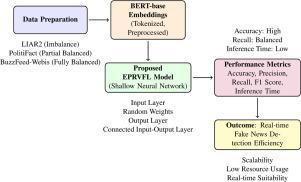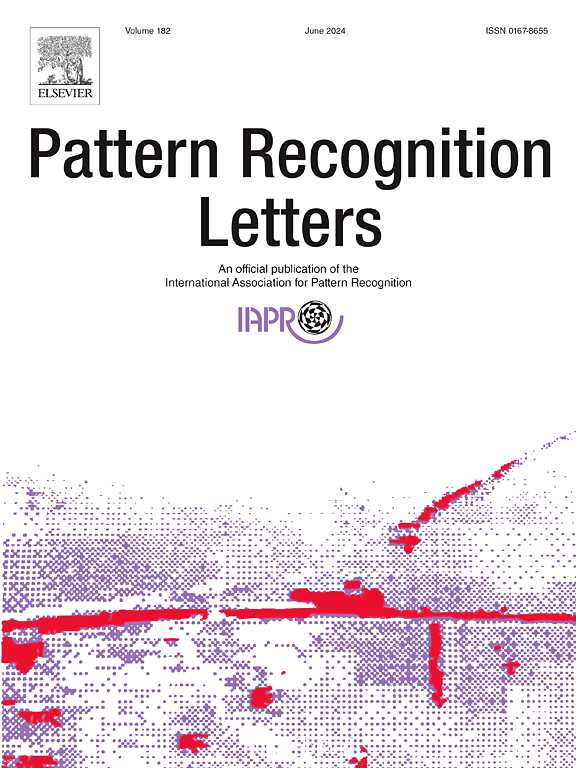EPRVFL: A fast and scalable model for real-time fake news detection
IF 3.3
3区 计算机科学
Q2 COMPUTER SCIENCE, ARTIFICIAL INTELLIGENCE
引用次数: 0
Abstract
The widespread dissemination of fake news on social media platforms emphasizes the need for efficient detection methods. In this research, we propose the Embedding Privileged Random Vector Functional Link (EPRVFL) model to improve the real-time detection of fake news while minimizing the inference time. In the proposed EPRVFL model, the text data with diverse datasets, PolitiFact, LIAR2, and BuzzFeed-Webis, were preprocessed and tokenized for analysis to ensure adaptability in various scenarios. The proposed model employs a shallow neural network with a connection between input and output layers to efficiently classify and integrate experimentally finalized bidirectional encoder representations from transformers (BERT) embeddings.
The proposed model achieves inference times of 0.0011 s, 0.0208 s, and 0.0053 s while maintaining high accuracies of 91.7722%, 74.6516%, and 70.3703% on PolitiFact, LIAR2, and BuzzFeed-Webis, respectively. Compared to CNN (1.3395 s, 72.0819%) and BiGRU (0.5518 s, 73.9547%), the EPRVFL ensures significantly faster inference with competitive accuracy. While BiLSTM achieves a higher precision (98.3471%) on PolitiFact, it requires 0.7674 s, making it less efficient in real-time scenarios. Similarly, FFNN shows the fastest inference (0.1103 s) but struggles with accuracy (59.4595%) on BuzzFeed-Webis. The proposed model’s balanced performance across precision, recall and F1 scores reinforces its robustness in fake news detection. The proposed EPRVFL model uniquely integrates BERT-base embeddings with a lightweight neural structure, ensuring rapid inference while maintaining robust accuracy, making it ideal for real-time applications. These findings provide analytical evidence for the model’s applicability in large-scale scenarios and the potential for future research by incorporating enhanced context analysis.

EPRVFL:一种快速、可扩展的实时假新闻检测模型
假新闻在社交媒体平台上的广泛传播强调了有效检测方法的必要性。在本研究中,我们提出了嵌入特权随机向量功能链接(EPRVFL)模型,以提高对假新闻的实时检测,同时最小化推理时间。在提出的EPRVFL模型中,对具有不同数据集(PolitiFact、LIAR2和BuzzFeed-Webis)的文本数据进行预处理和标记化以供分析,以确保在各种场景下的适应性。该模型采用具有输入和输出层连接的浅神经网络,有效地分类和整合实验确定的来自变压器(BERT)嵌入的双向编码器表示。该模型的推理时间分别为0.0011 s、0.0208 s和0.0053 s,同时在PolitiFact、LIAR2和BuzzFeed-Webis上分别保持了91.7722%、74.6516%和70.3703%的高准确率。与CNN (1.3395 s, 72.0819%)和BiGRU (0.5518 s, 73.9547%)相比,EPRVFL在具有竞争精度的情况下确保了更快的推理速度。虽然BiLSTM在PolitiFact上实现了更高的精度(98.3471%),但它需要0.7674 s,这使得它在实时场景中的效率较低。类似地,FFNN显示最快的推理(0.1103秒),但在BuzzFeed-Webis上的准确率(59.4595%)很差。该模型在精度、召回率和F1分数方面的平衡表现增强了其在假新闻检测中的鲁棒性。提出的EPRVFL模型独特地将基于bert的嵌入与轻量级神经结构集成在一起,确保快速推理的同时保持强大的准确性,使其成为实时应用的理想选择。这些发现为该模型在大尺度情景中的适用性提供了分析证据,并为未来的研究提供了增强的背景分析的潜力。
本文章由计算机程序翻译,如有差异,请以英文原文为准。
求助全文
约1分钟内获得全文
求助全文
来源期刊

Pattern Recognition Letters
工程技术-计算机:人工智能
CiteScore
12.40
自引率
5.90%
发文量
287
审稿时长
9.1 months
期刊介绍:
Pattern Recognition Letters aims at rapid publication of concise articles of a broad interest in pattern recognition.
Subject areas include all the current fields of interest represented by the Technical Committees of the International Association of Pattern Recognition, and other developing themes involving learning and recognition.
 求助内容:
求助内容: 应助结果提醒方式:
应助结果提醒方式:


